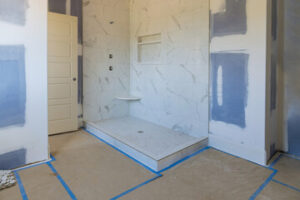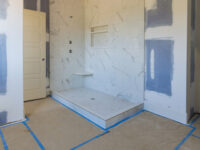From Dated to Deluxe: Essential Steps for a Successful Bathroom Renovation
Bathroom Remodel Lexington KY takes a significant time commitment from you and your contractor. To ensure a successful project, plan and get the basics in place.
Create a budget and prioritize your wish list into must-haves and nice-to-haves. This will allow you to have an honest discussion with contractors about what can and cannot be done within your budget.
Plumbing
 A bathroom remodel is a significant home improvement project often requiring plumbing work. Most bathroom renovations include moving existing fixtures, replacing piping, and laying new plumbing lines. The first step involves assessing the existing plumbing and planning the layout of the new bathroom. This will determine what kind of fixtures and pipes are needed. It’s important to find a plumber who has experience working on remodeling projects. They can help you create a budget and timeline that will ensure your project is completed within your expected timeframe.
A bathroom remodel is a significant home improvement project often requiring plumbing work. Most bathroom renovations include moving existing fixtures, replacing piping, and laying new plumbing lines. The first step involves assessing the existing plumbing and planning the layout of the new bathroom. This will determine what kind of fixtures and pipes are needed. It’s important to find a plumber who has experience working on remodeling projects. They can help you create a budget and timeline that will ensure your project is completed within your expected timeframe.
Many older homes have galvanized plumbing pipes that are nearing the end of their lifespan. During a bathroom remodel, it’s a good idea to replace these pipes with new PEX flexible tubing for the water supply and PVC piping for the drain lines. This will make the bathroom more energy efficient and reduce the risk of leaks and water damage.
Another common problem during bathroom renovation is clogged drains. This can be caused by a variety of factors, including the size of the drain opening and the presence of hair and soap scum. Increasing the drain opening and cleaning out a regular basis can help reduce clogs.
Depending on the scope of your bathroom remodel, you may need to obtain permits and building board approvals. This can add a few weeks to the overall timeline. Be sure to clear your schedule and prepare for some disruption in your daily routine. It’s also a good idea to remove or cover any furniture and belongings in the vicinity of the construction zone to prevent damage. It’s important to remember that the inconvenience and mess of a bathroom remodel are temporary, and it will be worth it in the end when you have a beautiful new bathroom.
Electrical
During a remodel, it is possible that the electrical needs of a bathroom will change. A professional electrician will be able to assess the situation and ensure that the new wiring configuration complies with current standards for safe electrical use in bathrooms.
While renovations are typically cosmetic, remodeling can involve substantial changes to a bathroom’s layout, design and functionality. Significant changes such as tearing down walls to increase space, changing the position of fixtures and pipes, absorbing a closet, expanding the bathing area, or converting a bathtub into a shower are all considered remodels. This type of work requires significant construction and can be expensive.
Any remodeling project should start with a clear idea of what you hope to achieve and an understanding of your budget. This will help you communicate with contractors and avoid costly mistakes. Before you hire a contractor, make sure they are licensed by checking with your local municipality’s licensing requirements.
It is also a good idea to move any valuables out of the bathroom before construction begins and cover any furniture that will be in the way. Construction can create dust and debris that could damage items, so removing or covering them ahead of time will prevent unnecessary costs.
When it comes to the electrical, a bathroom remodel should include GFCI outlets and switches within 3 feet of any sink or water source. This will help reduce safety hazards associated with electricity and water by shutting off power in the event of a short circuit or shock. A professional electrician can advise on where the best location for these outlets should be based on your bathroom’s usage patterns and your preferred aesthetic.
Ventilation
A bathroom remodel is a project that includes any improvements that change the layout, add or remove features, or modify fixtures and materials. It can range from repainting the vanity or swapping out a mirror to gutting the entire room and starting from scratch.
Even simple improvements can make the space more user-friendly and safe. For example, older homes often contain electrical outlets that are too close to water sources, which can be a fire hazard. Installing more secure plugs and running wire to relocate outlets away from water sources can prevent accidents.
Another important part of any bathroom remodel is ventilation. Without adequate ventilation, humidity levels rise quickly in the space after a shower or bath, which can cause water residue and mold to build up on surfaces. Opening a window is a quick solution, but it requires a lot of time for the space to cool down, and it can lead to energy waste because so much energy is used heating the room back up.
Installing a new bathroom fan is an easy project for most homeowners to do, as long as the existing vents and electrical connections are intact. However, if the bathroom is in a room with no vents or in a home without a roof (or attic), it can be more involved. A professional HVAC contractor can fabricate a duct run that goes from a ceiling-mounted fan in the wall, down through the floor and between the floor joists, then out through the roof.
A full gut and replace bathroom remodel is one where the existing walls and the room perimeter remain intact, but everything inside is replaced, from a toilet to the shower or bathtub, a vanity sink cabinet, lighting, flooring and so on. This is a more complicated project than a simple renovation and will usually require a permit.
Cabinetry
Cabinetry is a vital part of any bathroom remodel. It allows you to get your products off the counter and out of sight, eliminating visual clutter. Storage can also be a stylish design element that complements your other design choices.
A cabinet design consultant can help you determine the type and size of cabinets that will work best in your space. They’ll take into consideration your budget, layout and design goals to make recommendations based on current trends, remodeling standards and codes, and cabinet line capabilities. They’ll also be able to answer questions about the process of obtaining permits, the timeline of your project and the overall cost.
There are a variety of cabinet options available, from stock and semi-custom to custom cabinets. Cabinets are a big investment, and you’ll want to take your time in the selection process. It’s a good idea to choose one or two samples of cabinetry, so you can see how they look in your space and decide if they fit with your vision for the room.
You’ll also have to decide what extras you’d like to include. Master bathrooms typically need more storage than smaller single vanities or powder rooms, and may benefit from extra features like drawers, hamper pullouts and custom shelving.
Other upgrades can be as simple as a new light fixture or fresh wall art. Or you could give your bathroom a whole new look by changing the tile. Tile isn’t as costly as cabinetry, but it can make a big impact on the style of your bathroom. And don’t forget the lighting — dimmers are a great way to control the mood, while adding recessed fixtures around the mirror or pendants over the tub will add a luxe feel.
Flooring
Your flooring is another important feature to consider during a bathroom remodel. You can choose to install tile, hardwood or another material that suits your style and budget. It’s best to consult with a professional who can walk you through the specific installation process for your desired flooring.
Depending on the type of flooring you select, you may need to hire an installer or install it yourself. A skilled professional can help you avoid common mistakes that could cause problems later on.
If you’re looking to get a more modern look, consider installing laminate floors. These affordable substitutes for natural wood are made from wood byproducts and come in a wide range of designs, colors and thicknesses. Laminate is also more resistant to moisture damage than carpeting or tile.
A more luxurious option is engineered wood flooring. These durable floors can withstand moisture and humidity more effectively than traditional hardwood, and they have the aesthetic appeal of real wood without the maintenance worries.
For a more rugged, industrial look, you can opt for concrete floors. These edgy alternatives to ceramic tiles can be stained and sealed for a custom color and finish. However, concrete is porous and susceptible to water damage. If you decide to go with this material, you’ll need a waterproof barrier installed by a professional.
When selecting a contractor to handle your bathroom remodel, make sure you interview several candidates and ask for proposals and estimates. A reputable contractor should be licensed, carry personal liability and workers’ compensation insurance and provide you with a written contract that details all aspects of the project, including start and completion dates. This contract should also include a detailed breakdown of the costs associated with each item.






